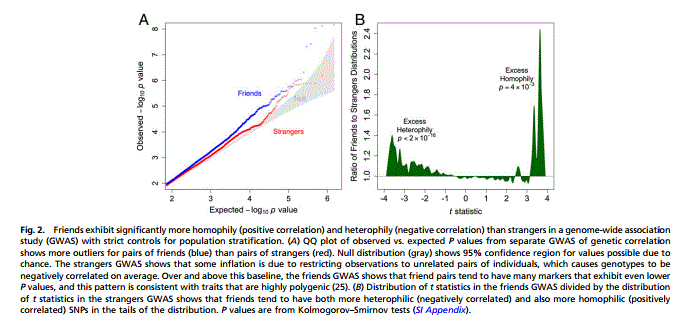Using data from a multi-decade medical research study of 1,932 people in Framingham, MA (a heart-disease research project that dates to 1948), Christakis and Fowler compared the genotypes of friends and strangers. They calculated a "kindship coefficient"--the probability that two alleles sampled at random from two individuals are identical by state: "positive values indicate that genotypes are positively correlated, and negative values indicate that two individuals are not related and, in fact, tend to have opposite genotypes."
They found that friends' genotypes tend to be positively correlated, or homophilic: we tend to pick friends who are genetically similar to us (as genetically similar as fourth cousins) in ways that go beyond superficial features. In other words, genetic-likes attract. For example, "We tend to smell things the same way that our friends do," Fowler says. This suggests that as humans evolved, the ability to tolerate and be drawn to certain smells may have influenced where people hung out. "You may really love the smell of coffee. And you're drawn to a place where other people have been drawn to who also love the smell of coffee," Fowler says. "And so that might be the opportunity space for you to make friends. You're all there together because you love coffee and you make friends because you all love coffee."
Interestingly, Christakis and Fowler also found evidence of heterophily, in that friends and spouses tend to have very different genes for their immune systems. "One of the reasons why we think this is true is because it gives us extra protection. If our spouses have an immune system that fights off a disease that we're susceptible to, they'll never get it, and then we'll never get it," Fowler says. "And so it gives us an extra layer of protection."
The authors conclude that
"the human evolutionary environment is not limited to the physical environment (sunshine, altitude) or biological environment (predators, pathogens) but also includes the social environment, which may itself be an evolutionary force. Our finding that positively correlated genotypes are under positive selection suggests that the genes of other people might modify the fitness advantages of one’s own genes, thus affecting the speed and outcome of evolution. In particular, communication—whether involving scent, sight, or sound—may be the key to this synergy. The human capacity to collaborate not only with kin but also with unrelated members of our species may have dramatically increased the potential gains from synergy, and this shift not only would favor interactions with generally similar partners, but also would affect the overall desire to search out such partners. Therefore, it is possible that we evolved a predilection for homophily once we started to frequently interact socially with unrelated individuals. Such an effect would especially speed up the evolution of phenotypes that are intrinsically synergistic, and this observation may help shed light on the finding that evolution in humans is accelerating."Read more:
http://www.washingtonpost.com/national/health-science/research-human-friendships-based-on-genetic-similarities-beyond-the-superficial/2014/07/14/8aea04fe-0ab5-11e4-8c9a-923ecc0c7d23_story.html
http://www.pnas.org/content/early/2014/07/10/1400825111.full.pdf+html
TeachingwithData.org resources:
Is Love Really Blind?: A Data-Driven Learning Guide (http://www.teachingwithdata.org/resource/3926)
Intergroup Relationships - Attitudes and Behaviors: A Data-Driven Learning Guide (http://www.teachingwithdata.org/resource/3450)






No comments :
Post a Comment